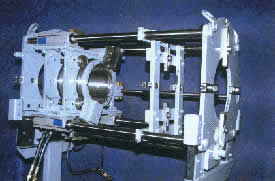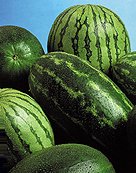how to find the volume
4a. Volume of Solid of Revolution by Integration (Disk method)
by M. Bourne

A lathe
Many solid objects, especially those made on a lathe, have a circular cross-section and curved sides. On this page, we see how to find the volume of such objects using integration.




Objects made on a lathe ...
Example 1
Applications
Don't miss the winecask and watermelon applications in this section.
Consider the area bounded by the straight line `y = 3x`, the `x`-axis, and `x = 1`:
When the shaded area is rotated 360° about the `x`-axis, a volume is generated.
The resulting solid is a cone:
Disk Method for Finding Volumes
To find this volume, we could take slices (the dark green disk shown above is a typical slice), each `dx` wide and radius `y`:
The volume of a cylinder is given by:
`V = πr^2h`
Because `"radius" = r = y` and each disk is `dx` high, we notice that the volume of each slice is:
`V = πy^2\ dx`
Adding the volumes of the disks (with infinitely small `dx`), we obtain the formula:
`V=pi int_a^b y^2dx` which means `V=pi int_a^b {f(x)}^2dx`
where:
`y = f(x)` is the equation of the curve whose area is being rotated`a` and `b` are the limits of the area being rotated
`dx` shows that the area is being rotated about the `x`-axis
NOTE: On this page we use the disk method and washer method (where we cut the shape into circular slices) only, and meet the Shell Method next).
Applying the formula `V=pi int_a^b y^2dx` to the earlier example, we have:
`"Vol" =pi int_a^b y^2dx`
`=pi int_0^1(3x)^2dx`
`=pi int_0^1 9x^2dx`
`=pi[3x^3]_0^1`
`=pi[3]-pi[0]`
`=3pi\ "unit"^3`
CHECK: Does the method work? We can find the volume of the cone using
`"Vol"=(pi r^2h)/3`
` = (pi(3)^2(1))/3`
`=(9pi)/3`
`=3pi\ "unit"^3` (Checks OK.)
Example 2
Find the volume if the area bounded by the curve `y = x^3+ 1`, the `x`-axis and the limits of `x = 0` and `x = 3` is rotated around the `x`-axis.
Answer
Volume by Rotating the Area Enclosed Between 2 Curves
If we have 2 curves `y_2` and `y_1` that enclose some area and we rotate that area around the `x`-axis, then the volume of the solid formed is given by:
`"Volume"=pi int_a^b[(y_2)^2-(y_1)^2]dx`
In the following general graph, `y_2` is above `y_1`. The lower and upper limits for the region to be rotated are indicated by the vertical lines at `x = a` and `x = b`.
`y_2`
`y_1`
Area bounded by the curves `y_1` and `y_2`, & the lines `x=a` and `x=b`.
When we rotate such a shape around an axis, and take slices, the result is a washer shape (with a round hole in the middle).
Example 3
A cup-like object is made by rotating the area between `y = 2x^2` and `y = x + 1` with `x ≥ 0` around the `x`-axis. Find the volume of the material needed to make the cup. Units are `"cm"`.
Answer
Rotation around the y -axis
When the shaded area is rotated 360° about the `y`-axis, the volume that is generated can be found by:
`V=pi int_c^d x^2dy` which means`V=pi int_c^d {f(y)}^2dy`
where:
`x =f(y)` is the equation of the curve expressed in terms of `y``c` and `d` are the upper and lower y limits of the area being rotated
`dy` shows that the area is being rotated about the `y`-axis
Example 4
Find the volume of the solid of revolution generated by rotating the curve `y = x^3` between `y = 0` and `y = 4` about the `y`-axis.
Answer
Exercises
Find the volume generated by the areas bounded by the given curves if they are revolved about the given axis:
(1) The straight line `y = x`, between `y = 0` and `x = 2`, revolved about the `x`-axis.
Answer
(2) The curve `y = 2x − x^2` bounded by `y = 0`, revolved about the `x`-axis.
Answer
(3) The curve `y^2 = x`, bounded by `y = 4` and `x = 0`, revolved about the `y`-axis.
Answer
(4) The curve `x^2 + 4y^2 = 4` in quadrant I, revolved around the `y`-axis.
Answer
Applications
1. Volume of a wine cask

A wine cask has a radius at the top of 30 cm and a radius at the middle of 40 cm. The height of the cask is 1 m. What is the volume of the cask (in L), assuming that the shape of the sides is parabolic?
Answer
2. Volume of a watermelon

A watermelon has an ellipsoidal shape with major axis 28 cm and minor axis 25 cm. Find its volume.
Historical Approach: Before calculus, one way of approximating the volume would be to slice the watermelon (say in 2 cm thick slices) and add up the volumes of each slice using `V = πr^2h`.
Interestingly, Archimedes (the one who famously jumped out of his bath and ran down the street shouting "Eureka! I've got it") used this approach to find volumes of spheres around 200 BC. The technique was almost forgotten until the early 1700s when calculus was developed by Newton and Leibniz.
We see how to do the problem using both approaches.
Volume using historical method:
Answer
"Exact" Volume (using Integration):
Answer
[See also Archimedes and the area of the parabolic segment.]
how to find the volume
Source: https://www.intmath.com/applications-integration/4-volume-solid-revolution.php
Posted by: penachem1942.blogspot.com

0 Response to "how to find the volume"
Post a Comment